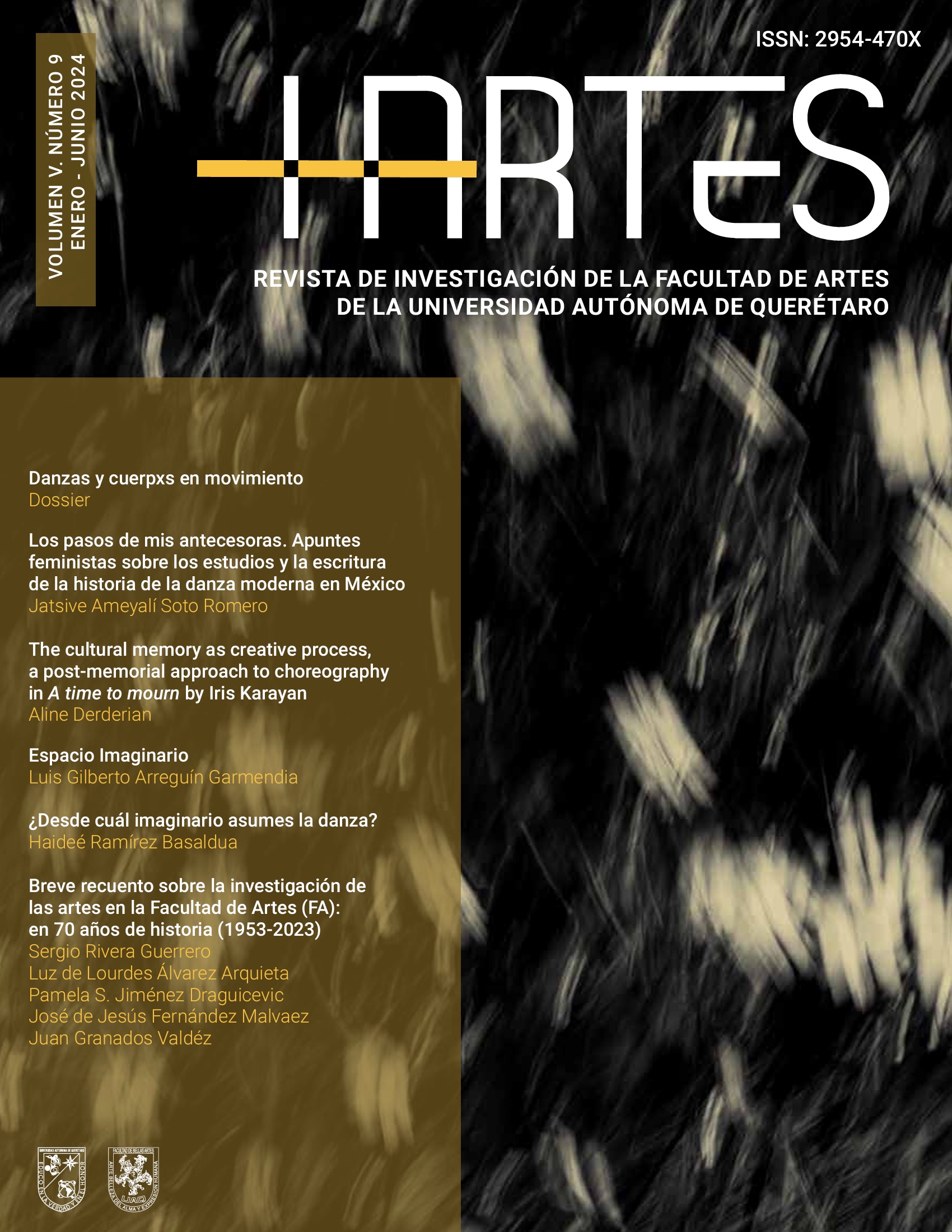Abstract
This article discusses the history of modern dance in Mexico by questioning the ways in which it has been written and understood based on patriarchal and colonial parameters. Despite the efforts to recover it from academic research, Mexican dance has been a neglected expression in the history of art in the country. The text focuses on a specific period known as "the golden age of Mexican modern dance", which spans from 1939 to the late 1950s, and has been thought of as an extension of artistic nationalism.
The text raises the importance of analyzing the history of Mexican modern dance from a feminist perspective and within the context of art history. Although women were, for the most part, the creators of the great symbols of national unity in terms of dance, they have rarely been recognized as creators, although dance has been mostly conceived and executed from female bodies, which has led it to be considered as a "feminine art", limiting its study from the predominantly male academies of art history.
A methodological proposal is proposed to study the history of modern Mexican dance from the perspective of Latin American feminisms. Urging to recognize the work of women creators and to analyze their creations in their historical and cultural contexts. This article proposes to reevaluate the work of women in Mexican modern dance, overcoming the patriarchal canons that have limited their visibility in academia and society. Through a feminist approach and an intersection of knowledge, it seeks to broaden the study of dance as an artistic expression in Mexico, recognizing and rewriting its history from a more inclusive and enriching perspective.
References
Arriaga, G. (2008). La Época de Oro de la Danza Moderna Mexicana. Consejo Nacional para la Cultura y las Artes.
BBC News. (13 de diciembre de 2017). “100 Women: «Why I invented the glass ceiling phrase»”. BBC News. Recuperado de https://www.bbc.com/news/world-42026266
Dallal, A. (1993). La danza contra la muerte. Ciudad de México: IIE-UNAM.
Giunta, A. (15 de septiembre de 2013). Andrea Giunta: «la historia del arte se ha escrito desde parámetros patriarcales» / Entrevistada por Alejandra Villasmil. Artishock Revista. Recuperada de https://artishockrevista.com/2013/09/15/andrea-giunta-historia-arte-parametros-patriarcales/
Giunta, A. (2019). Feminismo y Arte Latinoamericano: Historias de Artistas Que Emanciparon El Cuerpo. Ciudad de México: Siglo XXI Editores.
Hernández, S. (2012). Danza y nacionalismo en México (1931-1956). (Tesis de maestría) Universidad de Guadalajara, Jalisco, México.
Lavalle, J. (2002). En busca de la danza moderna mexicana: Dos Ensayos. Ciudad de México: Instituto Nacional de Bellas Artes.
Marín, N. (2004). La importancia de la danza tradicional mexicana en el Sistema Educativo Nacional (1921-1938): otra perspectiva de las misiones culturales. Ciudad de México: CONACULTA/INBA/Cenidi Danza/CENART.
Nochlin, L. (1988). “Why have there been no great women artists?” En L. Nochlin, Women, Art and Power and Other Essays (pp. 143-178). Nueva York: Harper and Row.
Pollock, G. (2013). Visión y diferencia: Feminismo, Feminidad e Historias del Arte. (L. M. Costa, trad.). Buenos Aires: Fiordo.
Pollock, G. (2014). “Whither Art History?” The Art Bulletin, 96 (1), pp. 9-23.
Ramos Smith, M. (2002). La danza en México: Visiones de cinco siglos. Ciudad de México: Cenidi Danza/INBA/CONACULTA/Escenología.
Reynoso, J. L. (2012) Choreographing Politics, Dancing Modernity: Ballet and Modern Dance in the Construction of Modern México (1919-1940). (Tesis de doctorado) University of California, Estados Unidos.
Sagaón, R. [IVEC Oficial]. (2015). Programa Ítaca - Rocío Sagaón 2a parte. [Archivo de video]. YouTube. Consultado 31 de julio de 2023 en https://www.youtube.com/watch?v=5jNO_CC0Tvs
Taylor, D. (2003). El archivo y el repertorio. El cuerpo y la memoria cultural en las Américas. Santiago de Chile: Ediciones Alberto Hurtado.
Tortajada, M. (1999). Mujeres de Danza Combativa. México: Consejo Nacional para la Cultura y las Artes.
Tortajada, M. (2001). Frutos de Mujer: Las mujeres en la Danza Escénica. Consejo Nacional para la Cultura y las Artes, Instituto Nacional de Bellas Artes y Literatura, Dirección General de Publicaciones.
Tortajada, M. [Centro Cultural de España en México]. (9 de diciembre de 2020). 16 días de activismo contra la violencia de género / Danza y feminismo a través de la historia. [Archivo de video]. YouTube. Consultado el 31 de julio de 2023 en https://www.youtube.com/watch?-v=5PYsrnK-V48
Villegas Morales, G. (2006). “Los grupos de arte feminista en México”. La Palabra y el Hombre, 137, (pp. 45-57). Recuperado de https://cdigital.uv.mx/bitstream/123456789/192/2/2006137P45.pdf

This work is licensed under a Creative Commons Attribution-NonCommercial-ShareAlike 4.0 International License.
Copyright (c) 2024 HArtes


